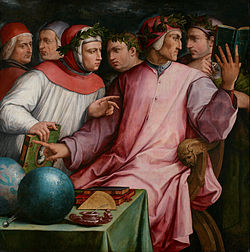
Back النهضة الإنسانية Arabic İntibah humanizmi Azerbaijani Ренесансов хуманизъм Bulgarian রেনেসাঁ মানবতাবাদ Bengali/Bangla Humanismus Czech Dyneiddiaeth y Dadeni Welsh Renæssancehumanisme Danish Renaissance-Humanismus German Αναγεννησιακός ουμανισμός Greek Renesanca Humanismo Esperanto

| Part of a series on |
| Humanism |
|---|
 |
| Philosophy portal |
Renaissance humanism is a worldview centered on the nature and importance of humanity that emerged from the study of Classical antiquity.
Renaissance humanists sought to create a citizenry able to speak and write with eloquence and clarity, and thus capable of engaging in the civic life of their communities and persuading others to virtuous and prudent actions. Humanism, while set up by a small elite who had access to books and education, was intended as a cultural movement to influence all of society. It was a program to revive the cultural heritage, literary legacy, and moral philosophy of the Greco-Roman civilization.
It first began in Italy and then spread across Western Europe in the 14th, 15th, and 16th centuries. During the period, the term humanist (Italian: umanista) referred to teachers and students of the humanities, known as the studia humanitatis, which included the study of Latin and Ancient Greek literatures, grammar, rhetoric, history, poetry, and moral philosophy. It was not until the 19th century that this began to be called humanism instead of the original humanities, and later by the retronym Renaissance humanism to distinguish it from later humanist developments.[2]
During the Renaissance period most humanists were Christians, so their concern was to "purify and renew Christianity", not to do away with it. Their vision was to return ad fontes ("to the pure sources") to the Gospels, the New Testament and the Church Fathers, bypassing the complexities of medieval Christian theology.[3]
- ^ "Six Tuscan Poets, Giorgio Vasari". collections.artsmia.org. Minneapolis, Minnesota: Minneapolis Institute of Art. 2023. Archived from the original on 17 June 2023. Retrieved 28 August 2023.
- ^ The term la rinascita (rebirth) first appeared, however, in its broad sense in Giorgio Vasari's Vite de' più eccellenti architetti, pittori, et scultori Italiani (The Lives of the Artists, 1550, revised 1568) Panofsky, Erwin. Renaissance and Renascences in Western Art, New York: Harper and Row, 1960. "The term umanista was used in fifteenth-century Italian academic slang to describe a teacher or student of classical literature and the arts associated with it, including that of rhetoric. The English equivalent 'humanist' makes its appearance in the late sixteenth century with a similar meaning. Only in the nineteenth century, however, and probably for the first time in Germany in 1809, is the attribute transformed into a substantive: humanism, standing for devotion to the literature of ancient Greece and Rome, and the humane values that may be derived from them" Nicholas Mann "The Origins of Humanism", Cambridge Companion to Humanism, Jill Kraye, editor [Cambridge University Press, 1996], p. 1–2). The term "Middle Ages" for the preceding period separating classical antiquity from its "rebirth" first appears in Latin in 1469 as media tempestas. For humanities as the original term for Renaissance humanism, see James Fieser, Samuel Enoch Stumpf "Philosophy during the Renaissance", Philosophy: A Historical Survey with Essential Readings (9th ed.) [McGraw-Hill Education, 2014]
- ^ McGrath, Alister (2011). Christian Theology: An Introduction (5th ed.). Oxford: Wiley-Blackwell. p. 30. ISBN 978-1-4443-3514-9.